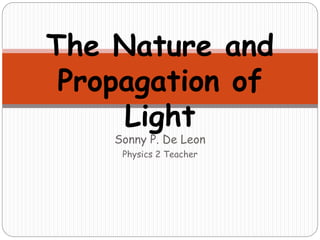
Nature-of-light.pptx
- 1. Sonny P. De Leon Physics 2 Teacher The Nature and Propagation of Light
- 2. Optics- branch of physics which deals with the behavior of light and other electromagnetic waves.
- 3. Light, form of energy visible to the human eye that is radiated by moving charged
- 4. What is the nature of light? Scientists have learned through experimentation that light behaves like a particle at times and like a wave at other times. The particle-like features are called photon. Photons are different from particles of matter in that they have no mass and always move at the constant speed of about 300,000 km/sec (186,000 mi/sec) when they are in a vacuum. When light diffracts, or bends slightly as it passes around a corner, it shows wavelike behavior. The waves associated with light are called electromagnetic waves because they consist of changing electric and magnetic fields.
- 5. The Real Nature of Light The propagation of light is best described by a wave model, but understanding emission and absorption requires a particle approach.
- 6. The Nature of Light Wave Model of Light Particle Model of Light
- 7. Absorption and Emission of Light When a photon, or packet of light energy, is absorbed by an atom, the atom gains the energy of the photon, and one of the atom’s electrons may jump to a higher energy level. The atom is then said to be excited. When an electron of an excited atom falls to a lower energy level, the atom may emit the electron’s excess energy in the form of a photon. The energy levels, or orbitals, of the atoms shown here have been greatly simplified to illustrate these absorption and emission processes.
- 8. Sources of Light Sources of light differ in how they provide energy to the charged particles, such as electrons, whose motion creates the light. If the energy comes from heat, then the source is called incandescent. If the energy comes from another source, such as chemical or electric energy, the source is called luminescent.
- 9. Sources of Light Incandescent source of light --- Sun and all other stars, candle light, incadescent bulb, black body and all other thermal sources. Luminescent source of light --- Flourescent light that make use of chemical compounds called phosphors, light in T.V set, aurora borealis and aurora australis • Chemiluminescence occur s when a chemical reaction produces molecules with electrons in excited energy levels that can then radiate light. • When chemiluminescence
- 10. Electrons in the solar wind that sweeps out from the Sun become deflected in Earth’s magnetic field and dip into the upper atmosphere near the north and south magnetic poles. The electrons then collide with atmospheric molecules, exciting the molecules’ electrons and making them emit light in the
- 11. Other sources of Light In a synchrotron light source, electrons are accelerated by microwaves and kept in a circular orbit by large magnets. The whole machine, called a synchrotron, resembles a large artificial atom. The circulating electrons can be made to radiate very monochromatic light at a wide range of frequencies. A laser is a special kind of light source that produces very regular waves that permit the light to be very tightly focused. Laser is actually an acronym for Light Amplification by Stimulated Emission of Radiation.
- 12. No matter what is source, electromagnetic radiation travels in a vacuum at the speed of light.
- 13. The first demonstration that the speed of light is not infinite was made in 1876 by the Danish Astronomer Ole Romer, from the observation of one Jupiter’s satellite The first successful terrestrial measurement of the speed of light was made by French scientist Armand Fizeau in 1849 using a reflected light beam by a notched rotating disk. More refined versions of this experiment were carried out later in the 19th century by Jean Foucault in France and Albert A. Michelson in the United States.
- 14. From analysis of all measurements up to 1831, the most probable value for the speed of light at that time was c = 2.99792458 x 108 m/s.
- 15. Reflection and Refraction When a light wave strikes a smooth interface separating two transparent materials ( such as air and glass or water and glass), the wave in general partly reflected or refracted ( transmitted) into second material. Interface – is the line or plane between two different material mediums.
- 16. Example: When you look into a restaurant window from the street, you see a reflection of the street scene, but a person inside the restaurant can look out through the window at the same scene as light reaches him by refraction.
- 17. Optics- branch of physics which deals with the behavior of light and other electromagnetic waves. Geometric Optics – branch of optics representing waves in terms of rays. Physical optics- branch of optics dealing specifically with wave behavior.
- 18. If the interface is rough, both the transmitted and reflected light are scattered in various directions, and there is no single angle of transmission or reflection. Scattered reflection from a rough surface is called diffuse reflection.
- 19. Reflection at a definite angle from a very smooth surface is called specular reflection.
- 20. Geometric optics Light from the source is called incident ray, the ray that is reflected is the reflected ray. The reference line used for measuring angles ia a line that is normal or perpendicular to the surface. The line is normal line.